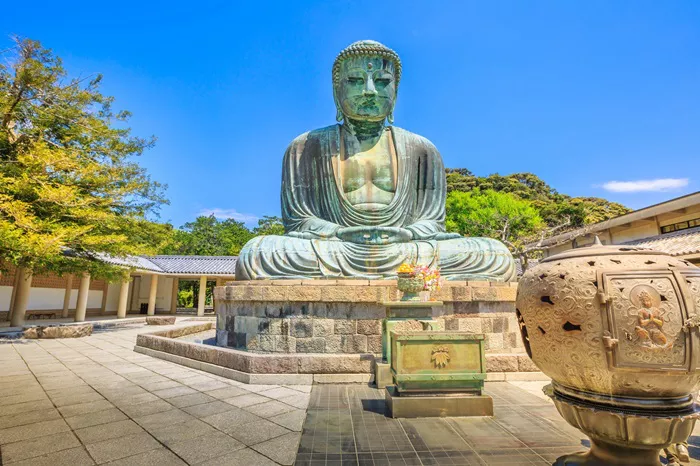The Great Buddha of Kamakura, known as Daibutsu, is a monumental bronze statue of Amida Buddha located in Kamakura, Kanagawa Prefecture, Japan. This iconic statue stands at approximately 11.4 meters (37 feet) tall and weighs about 121 tons, making it one of Japan’s most revered cultural and religious symbols.
Historical Background
The construction of the Great Buddha began in 1252 during the Kamakura period. Originally, the statue was housed inside a large temple hall. However, over the centuries, the temple buildings were destroyed multiple times due to natural disasters, including typhoons and a tsunami in the 14th and 15th centuries. Since the late 15th century, the Great Buddha has stood in the open air, enduring the elements and becoming a symbol of resilience and spiritual endurance.
Significance in Buddhism
The Great Buddha represents Amida Buddha, the central figure in Pure Land Buddhism. Amida is believed to offer salvation to all beings, regardless of their deeds, through the recitation of his name. The statue’s serene expression and imposing presence embody the compassion and wisdom of Amida, serving as a focal point for meditation and reflection for visitors and devotees alike.
Architectural and Artistic Features
The Great Buddha is crafted from bronze using a technique known as ikarakuri, involving the casting of separate sections that were later joined together. This method allowed for the creation of such a large and detailed statue. The statue’s features include:
- Height: Approximately 11.4 meters tall.
- Weight: About 121 tons.
- Facial Features: A serene expression with closed eyes and a gentle smile.
- Hands: Positioned in a specific mudra, symbolizing meditation and enlightenment.
- Interior: Hollow, allowing visitors to enter and view the interior structure.
Materials and Construction
The statue is primarily made of bronze, a material chosen for its durability and ability to withstand the elements. The casting process involved creating multiple sections, which were then assembled to form the complete statue. This technique showcases the advanced metallurgical skills of the artisans of the time.
Visiting the Great Buddha
The Great Buddha is located on the grounds of Kōtoku-in Temple, a Buddhist temple of the Jōdo-shū sect. The temple is situated in the Hase district of Kamakura, approximately a 7-minute walk from Hase Station on the Enoshima Electric Railway. Visitors can reach Kamakura from Tokyo in under an hour by train.
Opening Hours and Admission
The temple is open daily, with visiting hours from 8:00 AM to 5:30 PM during April to September, and 8:00 AM to 5:00 PM from October to March. The last admission is 15 minutes before closing. The entrance fee is 300 yen for adults and 150 yen for elementary school students. An additional 50 yen is required to enter the interior of the Great Buddha.
Experiencing the Interior
One of the unique aspects of the Great Buddha is its hollow interior. Visitors can enter the statue through a small opening and view the interior structure. Inside, one can observe the intricate casting techniques and the lattice pattern formed by the separate sections. This experience offers a deeper appreciation of the craftsmanship involved in creating such a monumental statue.
Religious and Cultural Importance
The Great Buddha is not only a significant religious symbol but also a cultural landmark. It attracts millions of visitors annually, including pilgrims, tourists, and scholars. The statue’s enduring presence serves as a reminder of Japan’s rich Buddhist heritage and the enduring values of peace, compassion, and enlightenment.
Spiritual Practices and Offerings
Visitors to the Great Buddha often engage in various spiritual practices, such as offering incense, making prayers, and reflecting in silence. The area surrounding the statue is designed to facilitate contemplation and meditation, providing a serene environment for spiritual reflection.
Preservation Efforts
Over the centuries, the Great Buddha has undergone several restoration efforts to preserve its structural integrity and appearance. These efforts include repairs after natural disasters and routine maintenance to protect the statue from environmental damage. The ongoing preservation of the Great Buddha ensures that future generations can continue to experience and learn from this remarkable symbol of Japanese Buddhism.
Conclusion
The Great Buddha of Kamakura stands as a testament to Japan’s rich Buddhist heritage and the enduring values of peace, compassion, and enlightenment. Its impressive size, intricate craftsmanship, and spiritual significance make it a must-visit destination for those interested in Japan’s cultural and religious history. Whether you are a devout Buddhist or a curious traveler, a visit to the Great Buddha offers a profound and enriching experience.

